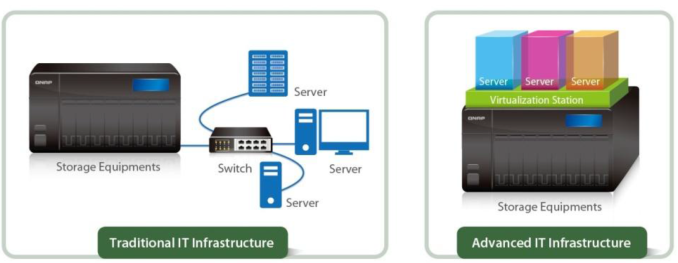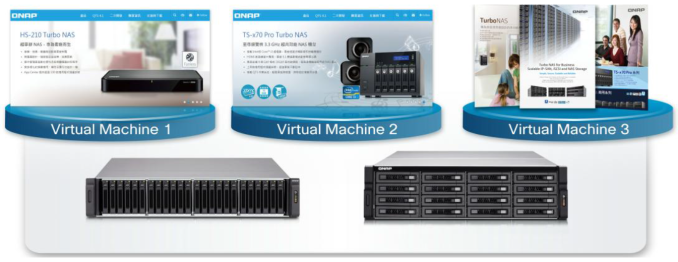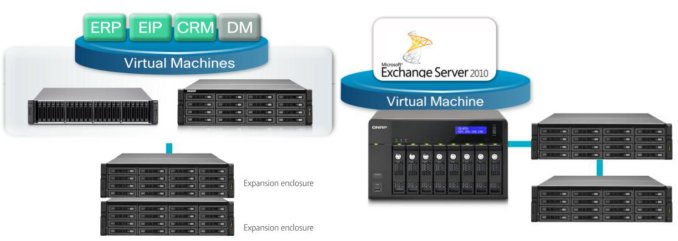NAS Units as VM Hosts: QNAP's Virtualization Station Explored
by Ganesh T S on August 18, 2014 10:15 AM EST- Posted in
- NAS
- Storage
- Virtualization
- QNAP
QNAP's Virtualization Station
The Virtualization Station package in QTS 4.x supports the installation of multiple operating systems in the VMs. QNAP contends that applications installed on VMs can improve the NAS compatibility (say, reading and working with CAD files can be achieved by installation of the appropriate software in the VM when such software is not available as a QTS package). The more obvious benefit is the aggregation of IT infrastructure.
The obvious benefits of VMs translate to the Virtualization Station package - efficiency in deployment, operation and management of systems.
Traditional NAS units carrying virtualization certifications (such as 'VMware Ready', 'Citrix Ready' and 'Windows Server Certified') provide support for virtualization by offering up storage in an easy-to-use manner (say, as iSCSI targets). Hardware-acceleration such as VMware VAAI and Windows ODX help in reducing the load on the server side by making the NAS do more of the work related to the storage (such as cloning of LUNs / copying data from one part of the LUN to another without clogging up the network links etc.). With Virtualization Station, the NAS itself can act as a hypervisor.
The Virtualization Station package allows running of multiple applications on different OSes at the same time. With the TS-451, however, only one guest OS can be active at a given point of time. Opening of files using VM-installed applications presents a number of benefits - there is no need to utilize the network bandwidth to download the file for opening through a local application - this is particularly useful for remote offices where data may have to travel outside the SMB's intranet. Under the same circumstances, avoiding the file's transfer through the network can also enhance security. Maintaining the data in a VM on the NAS also ensures availability (using QNAP's RAID implementation). QNAP's security apps (AV engines as well as firewall) provide added protection. The data on the Turbo NAS can be mounted via iSCSI or Samba on the VM. We will look into the practical aspects in the next section.
Even though the package doesn't allow for direct import of VHD files for creation of VMs, a wide variety of formats (OVA, OVF, QVM, XML and VMX) are supported in the import function. Similar to most other hypervisor solutions, we also have support for snapshots - these record VM RAM and volume ISO status at a given point in time for later roll-back (if necessary).
QTS also allows for assigning different VMs to different users, preventing accidental power-off or any other similar interruptions due to user errors. In terms of added flexibility, power scheduling of the VMs can also be set up.
In their marketing spiel, QNAP talks about four different use-cases for Virtualization Station:
- IIS web server: The package can allow a single QNAP NAS to host multiple web servers by operating existing web pages and databases on a VM. The NAS provides high-speed dedicated connections for each web server and large storage capacity.
- ERP / CRM systems: With a high-end QNAP NAS (Xeon-class CPU and 10 GbE) utilizing SSD caching, these applications can be provided excellent computing resources while ensuring continued data availability using the RAID storage of the NAS in the back-end.
- Microsoft Exchange Server: Many SMBs / SMEs already run their Exchange Server as a VM. Doing it on a QNAP NAS allows large storage capacity for the mail content. Data backup strategies can be executed easily and capacity expansion is also much simplified. From the end-user perspective, archived e-mails can be browsed without downloading.
- Windows Active Directory Server: A VM running this could be on the QNAP NAS and there would be no need for a separate physical machine on the network to run this.
All the use-cases highlighted above target SMB / SME applications. However, our focus today is on the TS-451 which targets enthusiasts and power users in the SOHO / home consumer category.













38 Comments
View All Comments
DanNeely - Monday, August 18, 2014 - link
Could you add the power level with the NAS idle and no VM running to the table on the last page of the article?ganeshts - Monday, August 18, 2014 - link
I have updated the article with the latest power numbers.iAPX - Monday, August 18, 2014 - link
It's not a NAS, it's a server that host up to 4-drives, and is clearly not targeted at data centers.Too expensive for SOHO, and anyway not good as a Virtualization platform (4GB or 8GB RAM max is really ridiculous to aggregate many little servers into a box), nor good as a NAS for enterprise (due to the encryption bandwidth cap), and worse when doing both of them (no more bandwidth aggregation!).
I wonder where is the market for such an hybrid, when I will instead use a simpler less expansive NAS on one side, and a dedicated VM server on the other (many cores and 32GB+ RAM) ?!?
ganeshts - Monday, August 18, 2014 - link
The target market is home users (power users / enthusiasts). Note that I haven't talked about the unit's transcoding capabilities (I mentioned it in the first review). QTS is a popular COTS NAS OS.I do agree on the expensiveness part - but, most other COTS NAS are in the same price range. QNAP is demanding a slight premium because of the virtualization and extensive transcoding features which no other COTS NAS has, as of now.
Btw, this unit has the capability to run only 1 VM. If you want multiple servers in a 'box', then, the higher end solutions such as the TS-EC1279U-RP are your best bet.
QNAP doesn't expect the TS-451 to be used as an Exchange server. The four use cases are meant for the rackmount units mostly.
I have already covered why the combo concept could be a better bet in many circumstances - data traffic doesn't clog up the network, power consumption with one physical machine is better than two. Again, it depends on how many VMs you want to run at the same time. The TS-451 is suitable for home use.
iAPX - Monday, August 18, 2014 - link
I understand your point, but in this case, a simpler NAS, with one or two Intel NUC wouldn't be better (and load-balanced to be crash-prone) ?And anyway more expandable, on the VM side, both in available CPU, RAM, or by adding simple inexpensive units?
ganeshts - Monday, August 18, 2014 - link
Taken standalone (just talking about virtualization features), you are definitely right about what provides more flexibility.However, when people look at the TS-451 as an 'appliance', they see the virtualization aspect as just one of the features. Transcoding is another major aspect (and put in all the myriad QTS applications like QSync, cloud access etc.). The whole is greater than the sum of the parts.
iAPX - Monday, August 18, 2014 - link
I don't buy it, because to use all of that you need to be a linux sysadmin wannabee, to install and run Linux VM (at least, or BSD, or ...). At this point you might be able to control your own set of dedicated servers.Anyway, I appreciated your follow-up to this article, and your point-of-view, it's great to have this level of commitment, and to be able to have insights when there's remaining questions. Kind regards.
ganeshts - Monday, August 18, 2014 - link
I am not sure I follow the 'linux sysadmin wannabee' aspect. You can install any type of VM you want - Windows or Linux or even Android.Transcoding - This is plug and play. After installing the NAS, accessing the video files in it through QNAP's mobile app - Qfile - can trigger the transcoding depending on what quality level is chosen. This is orthogonal to the VM feature. You don't need any VMs running to use the transcoding feature.
All QTS apps - These provide additional features and are again not depending on the VM aspect.
I fear I might not have effectively conveyed my points across.
bsd228 - Monday, August 18, 2014 - link
you'd need to be that sysadmin wannabee to deploy the NUC solution you suggest as well.iAPX - Monday, August 18, 2014 - link
Exactly, in both case you might need to be a sysadmin (even a wannabe! lol!), wether it's windows or linux doesn't count, as Ganesh stated, but if you know hot to install and handle a VM with an OS, and remote access it correctly, you have it needs to handle Intel NUC (or whatever is your VM host of choice), and don't need a box that will make it easier to handle different services.In fact I think there's a much more larger market for a NAS that don't have virtualization, (thus a less expensive tag price, and lighter CPU/RAM configuration) but provides these services through "bundles" or "plug-in" (whatever you call them) hosted on their main Linux OS.